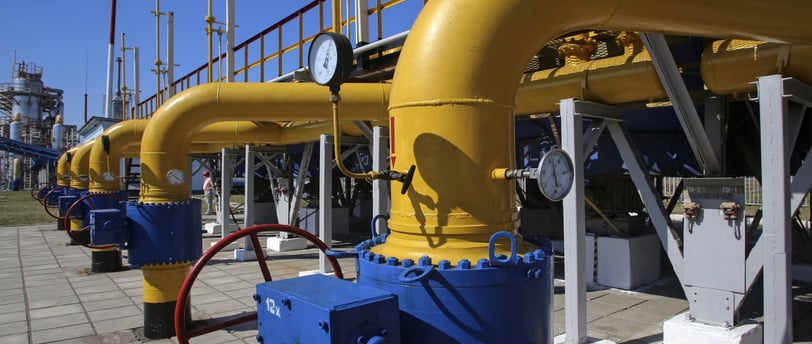Add your promotional text...
Natural Gas Market Heats Up: Analyzing the Factors Driving Prices Higher
Synopsis: Natural gas prices climbed by 0.85% to ₹284.3, fueled by forecasts of colder weather in the U.S., strong global LNG demand, and a tightening supply situation. This upward momentum highlights the critical role of storage levels, geopolitical factors, and market dynamics as the winter heating season progresses.
COMMODITIES
By Ekta Mani
12/30/20243 min read


Rising Natural Gas Prices: Key Drivers Behind the Momentum
Natural gas prices rose by 0.85% to ₹284.3, reflecting a confluence of factors ranging from weather forecasts to geopolitical tensions. These developments underscore the ongoing volatility in the global energy market and the strategic importance of natural gas as a vital energy source.
Weather Patterns and Seasonal Demand
One of the primary catalysts for the recent price increase is the forecast of colder-than-usual weather across the U.S. by mid-January. Colder temperatures translate to higher heating needs, boosting demand for natural gas.
Demand Surge:
Industry estimates over the weekend increased demand forecasts by 18 billion cubic feet (bcf), marking a notable shift as the winter season progresses.Storage Draws:
The market has already seen two consecutive weeks of storage draws exceeding 100 bcf, signaling the start of the withdrawal season and tightening supply levels.
Geopolitical Tensions Impacting Supply
Global geopolitical dynamics are playing a pivotal role in natural gas markets. Concerns over reduced Russian gas deliveries to Europe via Ukraine have significantly increased the demand for U.S. LNG exports.
EU’s Shift Toward Alternatives:
European Union nations continue to diversify gas sources, leaning heavily on U.S. LNG to reduce reliance on Russian supplies.U.S. LNG Exports Surge:
As EU nations scramble for alternatives, the demand for U.S. LNG has surged, providing a boost to domestic natural gas prices.
U.S. Production Trends
Natural gas production in the Lower 48 states averaged 103.1 billion cubic feet per day (bcfd) in December, a modest increase from November's 101.5 bcfd but below the record 105.3 bcfd achieved in December 2023.
Balancing Act:
While production levels remain robust, they have not kept pace with rising demand and storage withdrawals, adding upward pressure on prices.
Storage Levels and EIA Report Insights
According to the U.S. Energy Information Administration (EIA), natural gas inventories started the winter heating season at 3,922 bcf—the highest since 2016 and 6% above the five-year average.
Recent Withdrawals:
Utilities withdrew 93 bcf from storage last week, reducing stockpiles to 3,529 bcf. Although slightly below market expectations, this level is still 0.4% above the same period last year and 4.9% above the five-year average.Seasonal Impacts:
As the winter season deepens, further storage draws are anticipated, potentially creating tighter market conditions and additional upward pressure on prices.
Market Dynamics and Technical Indicators
Natural gas markets experienced notable short covering, evidenced by a 9.65% drop in open interest to 11,634 contracts. This activity coincided with a price increase of ₹2.4, signaling a potential shift in market sentiment.
Key Support and Resistance Levels:
Support Levels:
Immediate support lies at ₹278.7.
A breach could push prices further down to ₹273.1.
Resistance Levels:
Immediate resistance is at ₹293.1.
A breakout above this level could see prices test ₹301.9.
Global LNG Demand: A Supporting Pillar
The rise in natural gas prices is also supported by strong global demand for liquefied natural gas (LNG). As the energy transition accelerates and natural gas remains a cornerstone of global energy strategies, LNG demand continues to grow.
China's Role:
A recovering Chinese economy is driving increased LNG imports, further tightening the global supply-demand balance.Asia-Pacific Markets:
Other Asian nations, including Japan and South Korea, are also contributing to rising LNG demand amid colder seasonal weather.
What Lies Ahead for Natural Gas?
The future trajectory of natural gas prices will hinge on several factors:
Weather Developments:
Prolonged colder weather could intensify demand and further deplete storage levels.Geopolitical Stability:
Continued disruptions to Russian gas supplies or escalations in geopolitical tensions could amplify reliance on U.S. LNG.Market Sentiment:
Changes in trader sentiment, as indicated by open interest and price action, will also play a critical role.Supply Adjustments:
Any significant uptick in U.S. production or shifts in global supply dynamics could alter the market outlook.
In conclusion, Natural gas markets are navigating a complex landscape shaped by seasonal demand, geopolitical uncertainties, and evolving market dynamics. The recent price increase underscores the interplay of these factors, highlighting the need for vigilance among market participants.
As the winter heating season progresses, traders and investors should closely monitor weather forecasts, storage levels, and geopolitical developments. While the current momentum suggests further price increases, the market remains highly sensitive to external influences, setting the stage for continued volatility in the months ahead.
